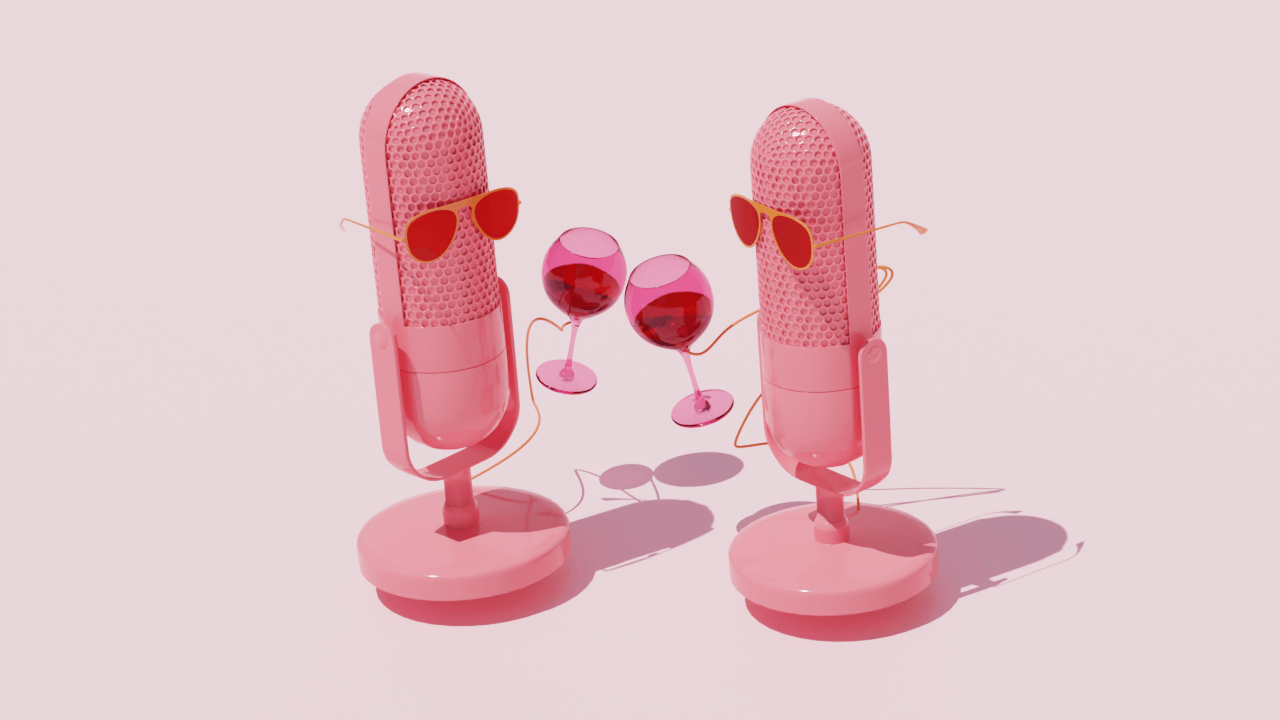When you host a party at your place, you’re not just focused on the drinks and the tunes. You’re also focused on the guest list, hoping that your friends from work will like your friends from art class — maybe so much that they become friends themselves.
The same is true of a podcast party. There are no cocktails at this kind of party (unless you want there to be) but there is a guest list: your podcast listeners. And if you throw a party with the right partner podcast, you can bring two audiences together — and maybe even help some listeners find their new favorite show.
In this article, you’ll learn what podcast parties are, how to host a successful podcast collaboration, and what to avoid if you’re looking to host a podcast party of your own.
What is a podcast party?
A podcast party is a creative collaboration between two or more podcast hosts where they record episodes together and share them on both podcasts. Most of the time, the hosts record one long episode, then split it in half. The first part airs on one show and the second half airs on the other show. But that’s not the only way it’s done; you could also record two truly separate, yet still related episodes and air one on each podcast, followed up with a promo telling the audience to go listen to the other episode on your collaborator’s show.
You could host a podcast party in any number of ways — the key is to publish related episodes to each participating show’s feed that tempt listeners into checking out a new podcast.
While this article centers on two-show podcast parties, there are ways to host a podcast party with even more hosts. One option would be for each podcast host to record a short episode with a predetermined time limit. You can then stitch these clips together and publish them as one episode on all of the podcast feeds.
This was done well on the Business Tip Road Trip episode of the This Can’t Be That Hard podcast, hosted by Annemie Tonken. This episode featured tips from Annemie along with the hosts of Shoot it Straight, Photo Biz X, Business-First Creatives, Focused Photographers, Art and Soul Show, and Photo Biz Help. The episode aired on the feeds of every participating podcast on the same week to maximize reach and promotions.

Podcast parties vs. feed swaps
It’s important to point out that podcast parties are different from podcast feed swaps. A feed swap occurs when two hosts agree to host an entire episode on the other person’s podcast feed. Podcast A would place their episode on Podcast B’s feed, and in turn, host the episode recorded by Podcast B on theirs. These episodes do not need to be linked and can be about different topics entirely. (They’ve also usually aired already; they’re just finding a new audience on a partner feed.)
A podcast party relies on collaborative content that encourages the audiences to go and listen to both feeds.
Colie James, host of Business-First Creatives, and Christina Torres, host of Best Regards, Christina hosted a podcast party this summer that did just that.


In that podcast party, the first half of the episode aired on Business-First Creatives and the second half aired the following week on Best Regards, Christina.
“Technically, each of those episodes was like a full episode by itself,” Colie said. “But we tried to make it a two-part conversation, where the two episodes were very connected, and if you got something out of one episode, you would probably get something out of the second.”
Why podcast parties work
Podcast parties are great for many reasons: a new point of view, shared expertise, more audience engagement, and the chance to build community.
But the biggest benefit for your show is cross promotion, especially when hosts have audiences of similar listeners. While a podcast feed swap is a great way to get in front of a completely new audience with an old episode, a podcast party encourages listeners to tune into both shows. It still helps with getting in front of a new audience, but because the episodes are new, existing listeners get to hear something fresh from their favorite host and get a taste of another show they might like. As a result, that audience might convert into longer term listeners for both shows more easily.
How to arrange a podcast party
Interested in hosting a podcast party of your own? Getting started is pretty easy.
“Like with any party, you’ve got to invite people,” Christina said. “So I reached out to Colie — we were in two groups together and we just seemed like we would really hit it off — and so I was like ‘Why don’t we do a podcast together? I’m happy to come on yours. You can come on mine. We can do both.’”
All it takes is a simple ask to begin the process of planning a podcast collaboration. Your process will likely look similar to finding partners for promo and feed swaps: you’ll want to make a list of all of the podcasts that are similar or related to yours, along with the name and contact information of the host. Then, start asking. If the first show turns you down, move on to the next until you find the perfect collaboration partner.
What makes a successful podcast party (and what to avoid)
A podcast party is a simple concept, but without the right planning, you'll miss out on some important benefits. Here's what to do — and what not to do.
Find an appropriate match in audience
But before you go in for the ask, think about whether or not the person you’re inviting is the right host to collaborate with. There are many podcast hosts that I admire and enjoy their content, but that doesn’t mean we’re well aligned to create shared content together.
To get the most out of your podcast party, it’s also important to align your show with one that has an audience who would also appreciate your own content. This doesn’t mean both hosts need to work in the same industry or have a show about the same topic. In fact, you may even get more value from collaborating with a host who’s slightly different from you since you’ll both bring varied perspectives to the table.
The key is just making sure that both audiences would be willing — excited even — to consistently tune into both of your shows in the future.
“Try to get someone who has a similar audience to you so that you can grow an audience of buyers or people who are more likely to come over to your podcasts and actually stick,” Christina said.
Both Colie and Christina noticed an increase in listens in the week that they did a podcast swap, but Colie pointed out that they didn’t plan in advance how to measure traffic, and in the future, she would approach it differently.
For example, in the Business Tip Road Trip podcast party she participated in with the This Can’t Be That Hard podcast (and other podcast hosts), Colie created an opt-in that was customized for that experience. Now, she knows exactly what traffic is converting from that podcast party.
Another audience consideration is size — but this doesn’t have to be the deciding factor. Ideally, you’ll be working with a host with an audience of a similar size or larger than yours. But remember that a small, engaged audience will get you more than a large but lukewarm one. And that engagement can be measured in multiple ways. For example, your podcast collaboration partner may have a smaller number of podcast downloads than you, but their email list or social media presence is much larger than yours. If they promote well to those channels, you should reap the benefits. Audience size could play a role in determining a good fit, but it shouldn’t be the only factor.
Consider their marketing efforts first
Another way to determine if a podcast party will be a successful collaboration effort is to match up your shows’ marketing efforts. You may consider turning down any requests from hosts who don’t consistently promote their own shows.
“If you’re someone who is very active in promoting your guest episodes — putting them on Instagram, sharing them with your newsletter, or possibly putting them on YouTube as a video podcast — I would highly recommend that you do a podcast party with other podcast hosts that do the same,” Colie said.
Just like with any school or work group project, a great outcome comes from shared responsibilities and maximum effort. “You don't want to come out on the other side of the collaboration feeling like you did more work to promote it than they did,” Colie said.
Build rapport
If you want a successful podcast collaboration, get to know the other podcast host before you press record. Even if you’ve communicated a lot on social media or via email, it’s important to talk first. You might find that your personal vibes don’t mesh well or the other host has a different energy than you. Building a rapport helps both hosts communicate better and feel more confident on recording day.
“Listen to their episodes and make sure that your values are aligned, and that you have the same kind of energy. I think that doing a podcast party is very difficult if you aren’t very high energy, or you have values that are not matched with the person that you do the pod party with,” Colie said.
Christina agrees. “If you’re not already super comfortable talking with that person, I would do a little preemptive one-on-one Zoom chat.”
Prepare in advance
After you found a great partner and committed to the collaboration, do some prep work before the podcast party. You’ll both want to determine what information you’d like to share between both episodes and then determine how to accomplish that together.
For example, in a podcast party where you and your partner host come up with six talking points, you might decide to include three in one episode and three in another. In another podcast collaboration, you might choose to use one episode to set up a scenario — say, sitting down to dinner with a picky toddler — and explain why the scenario is so important to the listener. You’d then use the other episode to explain how to achieve the ideal result of that scenario: 5 tips for a peaceful family meal, for example. In both instances, each episode relies on the other episode to complete the content.
Preparing in advance also sets up the hosts to feel more confident on the day of recording and know that everything they wanted to include got into the episodes.
“Even if you’re super comfortable with someone, having some points to kind of draw you back into the conversation helps,” Christina said. “I find when I’m not very prepared, I go off on tangents and I laugh and talk a lot, which isn’t really a satisfying sound experience.”
Prep for tech snafus
No matter how well prepared you are, know that you may experience tech issues when you meet to record your podcast party. And that’s exactly what happened to Colie and Christina. When they listened back, they realized their recording had fallen out of sync and they were speaking over each other in the second half of the conversation, which would be going live on Christina’s podcast.
“Christina and I recorded our two episodes back-to-back without stopping. Something got condensed in the download, and in the final version, we were totally talking over each other for the second half of the podcast. Now, I easily fixed it, but the next time that I did this kind of podcast collaboration, I made sure that we recorded one episode, we stopped, and then we started a second episode. I would never want to take the chance of investing so much time and energy into a collaboration like this, only to need to re-record because of a technical error,” Colie said.
Another good option would be to make a backup recording on each participant’s computer so you’ll have a solid episode no matter what happens.
Collaborate with curiosity
Here’s the thing: While initiating a podcast party is as simple as asking another podcast host to join you to create linked episodes, it may take some time and testing to figure out what you like, what works best for you and your show, and how you’ll approach collaborating with other hosts in the future.
Approach this new venture with curiosity and try on different approaches to see how they feel. There are no rules here!










































